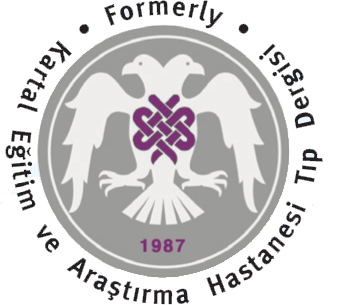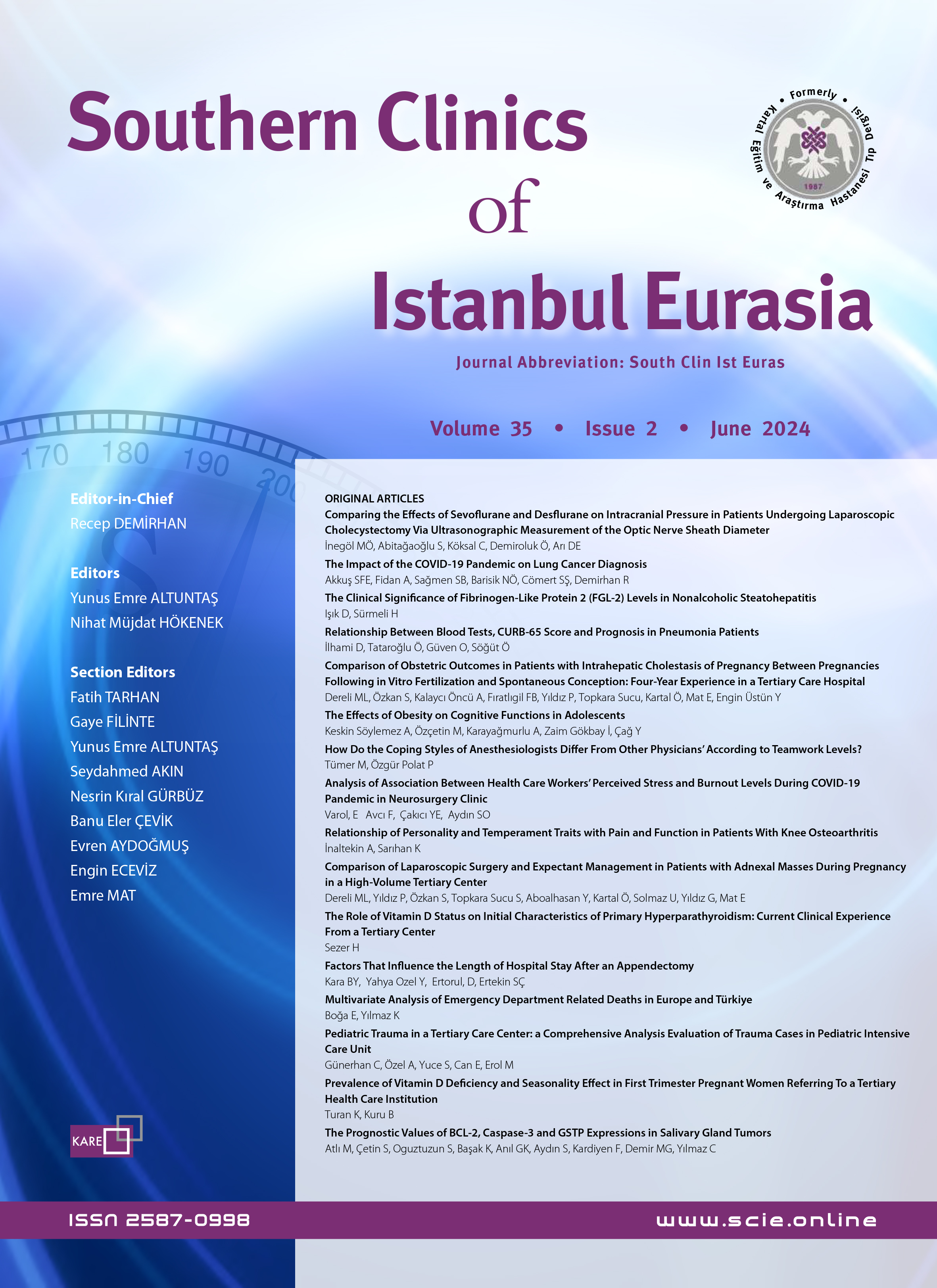Volume: 20 Issue: 1 - 2009
| RESEARCH ARTICLE | |
| 1. | HPV typing with PCR in cervical cancerous and precancerous lesions Dilek Yavuzer, Nimet Karadayı, Aykut Erdağı, Taflan Salepçi, Hüseyin Baloğlu, Reşat Dabak Pages 1 - 6 OBJECTIVE: The role of human papillomavirus (HPV) in the etiology of cervical neoplasia is now well established, however in our country, the knowledge of HPV prevalence in cervical lesions is still limited. The aim of this study was to investigate the prevalence of HPV DNA and to determine HPV types distrubution among women with cervical cancerous and precancerous lesions. METHODS: Fifty cervical tissues with invasive cervical carcinoma and cervical intraepithelial neoplasia (CIN) were screened by nested MY/GP polymerase chain reaction (PCR) for HPV DNA. RESULTS: Twenty-two samples were invasive cervical carcinoma, 12 were CIN 3, 7 were CIN 2 and 9 were CIN 1 lesions. Thirty-five out of 50 (70%) cervical tissues were positive for the HPV DNA. When typing was performed, the three most common HPV types were HPV 6/11 (42.9%), HPV 16 (22.9%) and HPV18 (14.3%), respectively. Dual HPV infections were found in 7 (20%) cases. CONCLUSION: HPV prevalence and type distrubition in our study population were different to that reported worldwide. This might be related to the geographic differences of prevalence and distrubition of HPV types around the world. However, as the number of study population was limited, the further and larger studies are needed to determine more reliable HPV prevalence and distrubition of HPV types in Turkish women. |
| 2. | Coexistence of gastrointestinal stromal tumors and malign epithelial tumors Dilek Yavuzer, Dilek Şakirahmet, Reşat Dabak, Aykut Erdağı, Nimet Karadayı Pages 7 - 12 OBJECTIVE: Gastrointestinal stromal tumors (GIST) are the most common mesenchymal tumors of the digestive system and they represent approximately 3% of all the gastrointestinal tumors. The aim of our study was to investigate the frequency of GIST concomitant with other malign epithelial tumors of the digestive system, to determine the localization, histopathologic and immunohistochemical features of the tumors in concomitant cases and compare with the cases that include only GIST. METHODS: Twenty-two cases of GIST diagnosed in the pathology department of our hospital are included in the study. From these cases, the GISTs concomitant with malign epithelial tumors were separated to form a different group. Immunohistochemically CD117 and CD34 expression were investigated in malign epithelial tumors in this group. RESULTS: Adenocarcinoma was found in 5 of the 22 cases (22.7%) concomitant with GIST. In these cases 3 of the GISTs were localised in the stomach, while 2 in the small bowel. GIST of this group belonged to low or very low risk group regarding aggressive behaviour. Adenocarcinoma seen with GIST were generally localized in the stomach and 3 of them were signet ring cell carcinoma. Immunohistochemical staining with CD34 and CD117 were not found in adenocarcinomas. CONCLUSION: There is a need of studies with large series in order to find an answer to the question of whether the synchronous occurence of GIST and malign epithelial tumors of the digestive system is coincidental or whether they have a common origin and carcinogenetic mechanisms. |
| 3. | The effects of ursodeoxycholic acid and glutamine on bacterial translocation, liver functions and hepatic histopathology in rats with obstructive jaundice Nejdet Bildik, Ayhan Çevik, Burak Kadıoğlu, Hüseyin Ekinci, Mehmet Altıntaş, Gülay Dalkılıç, Aylin Gül, Mustafa Gülmen Pages 13 - 21 OBJECTIVE: In this study, our aim was to investigate the effects of ursodeoxycholic acid and glutamine on bacterial translocation, hepatic histopathology and liver function tests in animal models with obstructive jaundice. METHODS: Sixty female Wistar Albino rats weighing 200-280 g were used. Twenty rats were assigned to each of three groups. The experiment group developed icterus on the 3rd postoperative day, and 10 mg/kg/day ursodeoxycholic acid (Ursofalk®) and 4 ml/kg/day L-alanyl L-glutamine solution (Dipeptiven®) were added to their diet with orogastric intubation on the 4th postoperative day. Investigated parameters were AST, ALT, ALP, GGT, total (T) bilirubin, and direct (D) bilirubin. Mesenteric, cecum and blood samples were collected in order to determine bacterial translocation. For measurement of biochemical parameters, blood sample was obtained. For histological investigation, samples of liver tissue were obtained. RESULTS: Our study demonstrated elevated levels of AST, ALT, GGT, ALP, and T and D bilirubin in rats with mechanical icterus. While the ursodeoxycholic acid and glutamine-administered group exhibited a significant decline in AST, ALT, GGT, ALP, and D bilirubin levels, there was no difference regarding T bilirubin levels. CONCLUSION: We concluded that in the case of bacterial translocation and liver damage, preoperative and postoperative ursodeoxycholic acid and glutamine administration in patients with mechanical icterus may have positive effects on morbidity and mortality. |
| 4. | The results of intramedullary nailing and Ilizarov external fixator applications in closed tibial fractures Cem Çopuroğlu, Mert Özcan, Osman Uğur Çalpur Pages 22 - 28 OBJECTIVE: In this study, we aimed to compare functional and radiological results of tibial diaphysis-fractured patients who were treated with intramedullary (IM) nailing or Ilizarov external fixation (EF) technique. METHODS: Twenty-six (19 male, 7 female; mean age 39.5 years; range 17 to 70 years) tibial diaphysis-fractured patients who had been treated surgically were evaluated. Follow-up results of 14 (53.8%) patients with IM nailing and 12 (46.2%) patients with Ilizarov EF were compared radiologically and functionally. RESULTS: The mean follow-up was 27.3 months (range 4 to 48 months). The average union time was 14 weeks (IM nailing 12.8 weeks, EF 15.3 weeks). No limitation in knee motion was observed. In both groups, when compared with the unoperated side, ankle motion was decreased. According to Johner and Wruhs criteria, 5 excellent (4 IM, 1 EF), 7 good (5 IM, 2 EF), 9 poor (2 IM, 7 EF) and 5 bad (3 IM, 2 EF) outcomes were determined. CONCLUSION: When we compared the treatment of closed tibia diaphysis fractures radiologically and functionally, IM nailing gives better results than Ilizarov EF. |
| 5. | The relationship between postoperative histopathologic examination and preoperative diagnostic methods in thyroid diseases Nejdet Bildik, Mehmet Mustafa Altıntaş, Erdoğan Aslan, Ayhan Çevik, Hüseyin Ekinci, Gülay Dalkılıç, Hande Altıntaş Pages 29 - 36 OBJECTIVE: The main diagnostic methods in thyroid diseases are thyroid ultrasound (US), thyroid scintigraphy and fine needle aspiration biopsy (FNAB). We aimed in this study to compare results of preoperative diagnostic methods and postoperative histopathologic examinations regarding the effectiveness of preoperative methods in patients operated for thyroid disease, based on our clinical experience. METHODS: One hundred twenty-five patients who were operated in our clinic between 2006 and 2007 were retrospectively reviewed. Data collected for each patient included: age, gender and preoperative US, scintigraphy, and FNAB findings. Preoperative findings were compared with postoperative histopathologic examination results. RESULTS: FNAB was benign in the majority of patients (88.8%), while our rate of malignant cytology was 11.2%. Postoperative histopathology results were largely benign (88% n=110), while the malignant pathology rate was 12% in patients who were operated. CONCLUSION: A statistically significant relationship was determined between preoperative FNAB and postoperative histopathology results. Thus, we believe that FNAB would be a sufficient diagnostic method in the majority of patients in the preoperative period. |
| CASE REPORT | |
| 6. | A case of multifactorial cerebrovascular disease complicated with rheumatoid arthritis Ülgen Kökeş, Fazilet Hız, Burcu Ertugrul Pages 37 - 41 The etiology of ischemic stroke without large and small artery damage or cardioembolism is vasculitis, hematologic dysfunction, coagulopathy, rarely seen diseases, or idiopathic. Rheumatoid arthritis within connective tissue diseases is the most common cause of vasculitis. A 47-year-old female had acutely presented with ischemic multiple small and large cerebral artery involvement. Investigation of etiology might confuse the diagnosis in the presence of collagenous tissue disease. Patients are sometimes diagnosed as multiple sclerosis, myasthenia gravis or parkinsonism. This case is important to emphasize etiologic research for the treatment and prognosis variabilities in collagenous tissue disease. |
| 7. | A rare outcome induced by metformin intoxication: Severe lactic acidosis and sudden cardiac arrest Gökhan Perincek, Ebru Çakır Edis, Sibel Güldiken, Mehmet Şevki Uyanık Pages 42 - 44 A 55-year-old male patient taking oral antidiabetics due to type 2 diabetes mellitus took 60 metformin HCL in a suicide attempt. The patient was conscious and the tests revealed pH: 7.29, PaCO2: 39, PaO2: 44, and lactate: 23.4. The patient was given 5 ampoules of NaHCO3 and NaHCO3 infusion was started. Dopamine infusion was added to the therapy due to hypotension. Lactic acidosis increased nevertheless, and the patients condition worsened, so intubation was performed. Hemodiafiltration due to increasing lactic acidosis was planned, but was not possible because of continuing hypotension. The patient died after cardiac arrest. |
| 8. | Vascular leimyoma originated from the inferior turbinate Belit Merve Şener, Cenk Evren, Nevzat Demirbilek, Ahmet Kaur Pages 45 - 49 Nose bleeding, particularly one-sided, is a common problem in elderly patients. It may be due to hypertension as well as the masses inside the nose. Leiomyomas are benign neoplasms that are thought to originate from the vascular smooth muscle. They are very rarely found in the head and neck area. Simple surgical excision yields high cure rates. A 58-year-old male presented with left-sided epistaxis. There has been no recurrence one year after the endoscopic excision of the nasal leiomyoma. In this paper, we present the clinical and histological features of a patient with leiomyomas of the nasal cavity together with a review of the literature. |
| 9. | Prostatic carcinosarcoma (Sarcomatoid carcinoma): Report of two cases Elife Kımıloğlu Şahan, Ayşenur Akyıldız İğdem, Tayfun Budak, Nusret Erdoğan Pages 50 - 53 Sarcomatoid carcinoma (carcinosarcoma) of the prostate is a rare type of prostatic neoplasm that demonstrates a combination of malignant epithelial and sarcomatoid components. The epithelial component of these tumors is often a high-grade adenocarcinoma. The sarcomatoid component often demonstrates a spindled appearance, although heterologous elements resembling osteosarcoma, chondrosarcoma and angiosarcoma may be present in a subset of cases. We present two cases (65- and 70-year-old males) whose prostate-specific antigen (PSA) levels were 1.5 and 5.6, respectively. Both cases had malignant tumors of the prostate, which contained both epithelial and sarcomatoid components. Immunohistochemically, pancytokeratin was positive in the carcinomatous component and vimentin was positive in the sarcomatoid component. To date, only a small number of prostatic carcinosarcomas have been reported in the literature. To further characterize these tumors, we examined clinical information and pathologic findings in two patients with sarcomatoid carcinomas of the prostate. |
| 10. | Isolated flexor pollicis longus muscle paralysis with anterior interosseous nerve palsy: A case report Muhsin Dursun, Serhat Gafur Karaca, Haldun Orhun, Volkan Gürkan, Ender Sarıoğlu, Güray Altun Pages 54 - 56 In this report, a 28 year-old male patient with acutely developing muscle weakness in the flexor pollucis longus is described. The patient presented with inability to flex his left interphalangeal joint. Electromyelographic studies showed anterior interosseous nerve entrapment neuropathy, and antiinflammatory drug therapy was initiated. Complete remission was achieved at the end of six weeks and no recurrence was observed during the one year follow-up. |



















